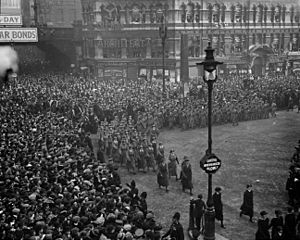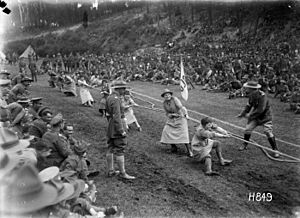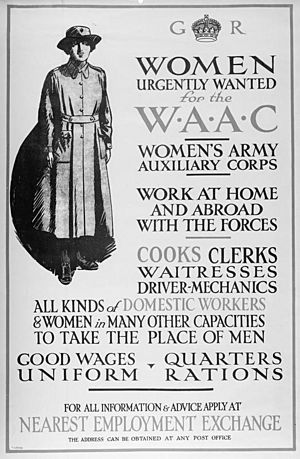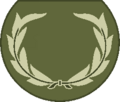Queen Mary's Army Auxiliary Corps facts for kids
Quick facts for kids Queen Mary's Army Auxiliary CorpsWomen's Army Auxiliary Corps |
|
|---|---|
 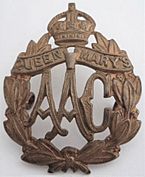
Cap Badge: WAAC and QMAAC
|
|
| Active | March 1917–April 1918: Women's Army Auxiliary Corps April 1918–Sept 1921: Queen Mary's Army Auxiliary Corps |
| Allegiance | |
| Branch | |
| Type | Women's administrative corps |
| Size | 57,000 passed through corps |
| Commanders | |
| Ceremonial chief | Queen Mary (Patron) |
The Women's Army Auxiliary Corps (WAAC) was a special group of women who helped the British Army during and right after World War I. It started in February 1917. Later, from April 9, 1918, it was known as Queen Mary's Army Auxiliary Corps (QMAAC). This group was officially closed down on September 27, 1921.
Contents
How the WAAC Started and Grew
The idea for the WAAC came about in January 1917. The army decided that women could do many jobs that didn't involve fighting. This would free up men to go to the front lines.
Recruiting for the WAAC began in March 1917. The group was officially formed on July 7, 1917. Dr. Mona Chalmers Watson was chosen as the first leader, called the chief controller. Between January 1917 and November 1918, more than 57,000 women joined the corps.
The WAAC had different sections. Women worked in cooking, mechanical tasks (like fixing things), and office jobs. Nursing was a separate service. However, a special medical group was set up to care for the QMAAC members.
Women Serving Overseas
On March 31, 1917, the first WAAC women went to France, where much of the fighting happened. There were only fourteen cooks and waitresses at first. Helen Gwynne-Vaughan was the main leader for the women serving overseas.
In 1918, women doctors also went to France to help the QMAAC. One brave doctor, Phoebe Chapple, received a special award called the Military Medal. She earned it for helping wounded people during an air raid in May 1918, even though it was dangerous. In total, five Military Medals were given to QMAAC members for their courage during air raids or shelling.
About 17,000 members of the corps served in other countries during the war. However, no more than 9,000 were overseas at any one time. In April 1918, nearly 10,000 women who worked at air stations joined a new group. This new group was called the Women's Royal Air Force, formed when the Royal Air Force was created.
End of the Corps
After the war ended in November 1918, the women in the corps started to go home. The WAAC was officially disbanded on September 27, 1921. The last known veteran of the QMAAC was Ivy Campany, who passed away in 2008.
Special Ranks and Badges
The WAAC and QMAAC had their own unique system for ranks, different from the regular army. These ranks were called "grades." The special badges for these grades were worn on their shoulders, except for forewoman and assistant forewoman, whose badges were on their upper right arm.
Here are some examples of the special badges used:
Important Records
Sadly, many of the service records for the women in the WAAC were destroyed. This happened during a German air raid in September 1940. Some records that survived were damaged by fire, water, and mold. To protect them, The National Archives made digital copies. You can now look at these records online.


